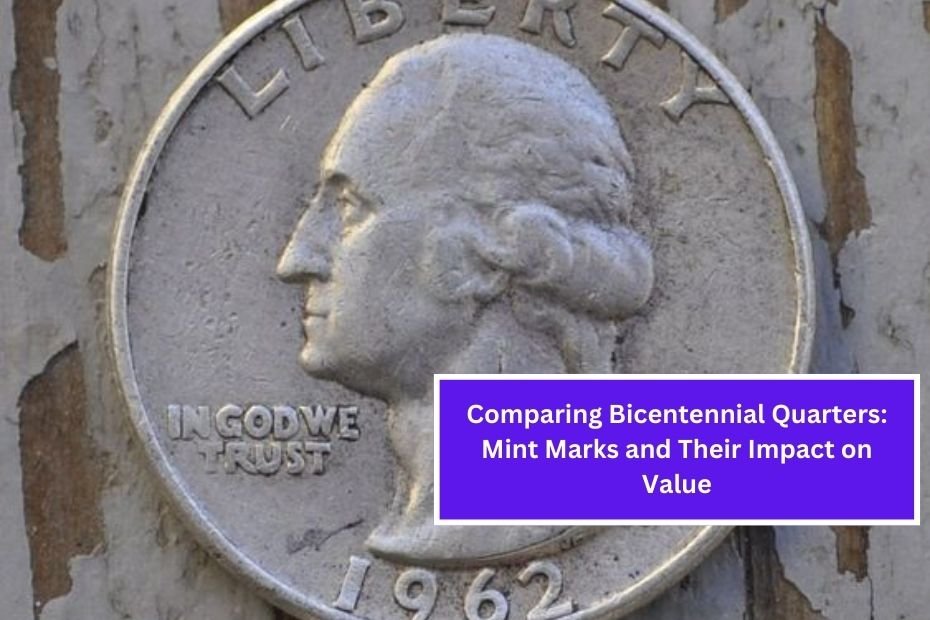The Bicentennial Quarter is a unique piece of American currency that commemorates the 200th anniversary of the United States. Released in 1975 and 1976, these quarters have become popular among collectors. One of the key factors that affect their value is the mint mark, which indicates where the coin was produced. In this article, we will explore the history of the Bicentennial Quarter, the significance of mint marks, and how they influence the value of these coins.
The History of the Bicentennial Quarter
In 1975 and 1976, the U.S. Mint released a special design for the quarter to celebrate the United States’ 200th birthday. This was part of a larger Bicentennial celebration that included various coins. The new design featured a depiction of the Revolutionary War-era drummer on the reverse side, while the obverse side retained the image of George Washington.
Design Changes
The design changes were significant because they only occurred for a limited time. The quarter was minted with two different dates (1776 and 1976), symbolizing the founding of the nation and its celebration in 1976. This dual-dating adds a unique aspect to the coin, making it even more desirable for collectors.
Understanding Mint Marks
Mint marks are small letters stamped on coins that indicate where they were produced. For the Bicentennial Quarter, there are three mint marks to be aware of:
- P (Philadelphia Mint): Coins produced at the Philadelphia Mint do not have a mint mark, as the Philadelphia Mint traditionally does not mark its coins. However, in 1976, the mint began using the “P” mint mark for the first time on quarters and other coins.
- D (Denver Mint): Coins produced at the Denver Mint have a “D” mint mark. This mint is known for producing a large number of coins and is one of the main mints in the United States.
- S (San Francisco Mint): Coins produced at the San Francisco Mint carry an “S” mint mark. These coins are often produced for collectors and are generally of higher quality.
Why Mint Marks Matter
Mint marks are essential for collectors because they can significantly impact a coin’s rarity and value. Coins produced in smaller quantities or specific locations may be more sought after than those that are more common. This is especially true for the Bicentennial Quarter, as the mint marks can indicate the coin’s scarcity.
The Rarity of Bicentennial Quarters
While the Bicentennial Quarter was produced in large quantities, some variations are rarer than others. For example, the San Francisco mint often produced coins with a higher level of quality, making them more desirable among collectors. Let’s break down the production numbers and rarity of each mint mark.
Production Numbers
- Philadelphia Mint (No Mint Mark): Approximately 1.6 billion quarters were minted without a mint mark.
- Denver Mint (D): Around 1.5 billion quarters were minted with the “D” mark.
- San Francisco Mint (S): The San Francisco Mint produced around 11 million quarters for collectors, making these coins significantly rarer.
Rarity and Demand
The rarity of the San Francisco minted quarters makes them more desirable. Collectors often seek out these coins to complete their collections or for investment purposes. The demand for these coins can drive up their prices, especially if they are in excellent condition.
Grading and Condition
The condition of a coin plays a crucial role in determining its value. Coins are graded on a scale from 1 to 70, with 70 being a perfect coin. The grading system evaluates factors such as wear, scratches, and overall appearance.
Coin Grades
- Good (G-4): The coin has significant wear, and details are difficult to see.
- Fine (F-12): The coin shows moderate wear, but major details are still visible.
- Very Fine (VF-20): The coin has light wear, with most details clear and sharp.
- Extremely Fine (EF-40): The coin shows minimal wear, and all details are well defined.
- Mint State (MS-60 to MS-70): These coins have no signs of wear and are considered uncirculated.
The better the condition of the coin, the higher its value. For example, a Mint State San Francisco Bicentennial Quarter can sell for much more than one in Good condition.
Market Value and Pricing
The value of Bicentennial Quarters can vary based on several factors, including mint mark, condition, and market demand. Here’s a general idea of the pricing you might expect for each type:
Philadelphia Mint (No Mint Mark)
- Good Condition: $0.25 – $1.00
- Very Fine: $1.00 – $3.00
- Uncirculated: $5.00 – $10.00
Denver Mint (D)
- Good Condition: $0.25 – $1.00
- Very Fine: $1.00 – $3.00
- Uncirculated: $5.00 – $15.00
San Francisco Mint (S)
- Good Condition: $1.00 – $3.00
- Very Fine: $3.00 – $10.00
- Uncirculated: $15.00 – $50.00 or more, depending on the quality.
These values are estimates and can change based on the coin market. Rare coins in exceptional condition can fetch much higher prices at auctions or from private collectors.
How to Collect Bicentennial Quarters
If you’re interested in collecting Bicentennial Quarters, here are some tips to get started:
- Do Your Research: Understand the different mint marks, production numbers, and grading systems. Knowledge is essential for any collector.
- Visit Coin Shows: Coin shows are a great place to find collectors and dealers. You can learn from experienced collectors and find unique coins for your collection.
- Join a Coin Club: Consider joining a local or online coin club. Clubs provide valuable resources and networking opportunities with fellow enthusiasts.
- Use Proper Storage: Keep your coins in a safe place, using holders or albums designed for coin storage. This helps prevent damage and keeps them in good condition.
- Stay Updated on Market Trends: The value of coins can fluctuate, so it’s important to keep track of market trends. Websites, publications, and forums dedicated to coin collecting can provide valuable insights.
Conclusion
The Bicentennial Quarter is more than just a piece of currency; it represents a significant moment in American history. Understanding the importance of mint marks and their impact on value can help collectors make informed decisions. Whether you are a seasoned collector or just starting, these quarters offer an exciting opportunity to explore the world of numismatics.
As you delve into your collection, remember to appreciate the history behind each coin and the role it plays in American culture. With a little research and dedication, you can build a collection that not only has financial value but also tells a story about the nation’s heritage. Happy collecting!

